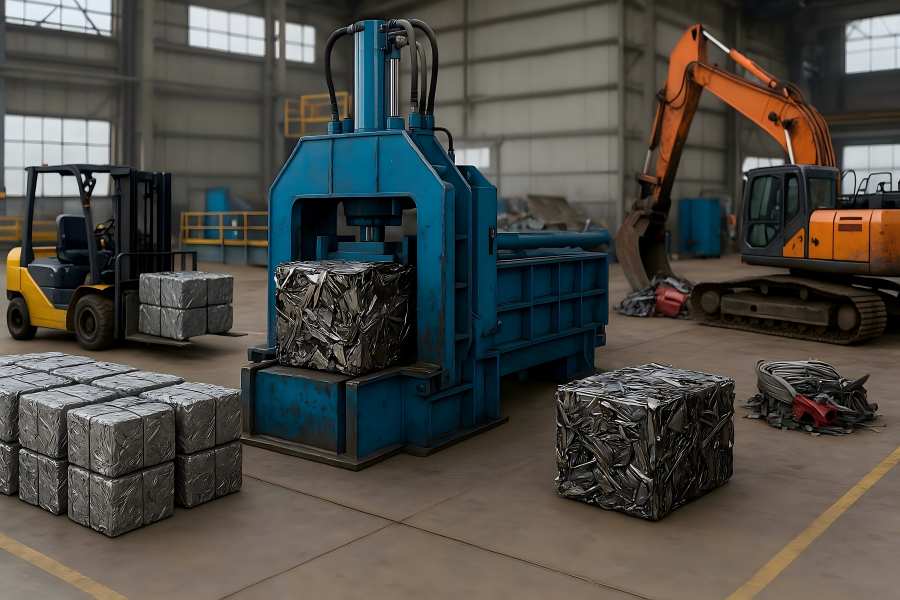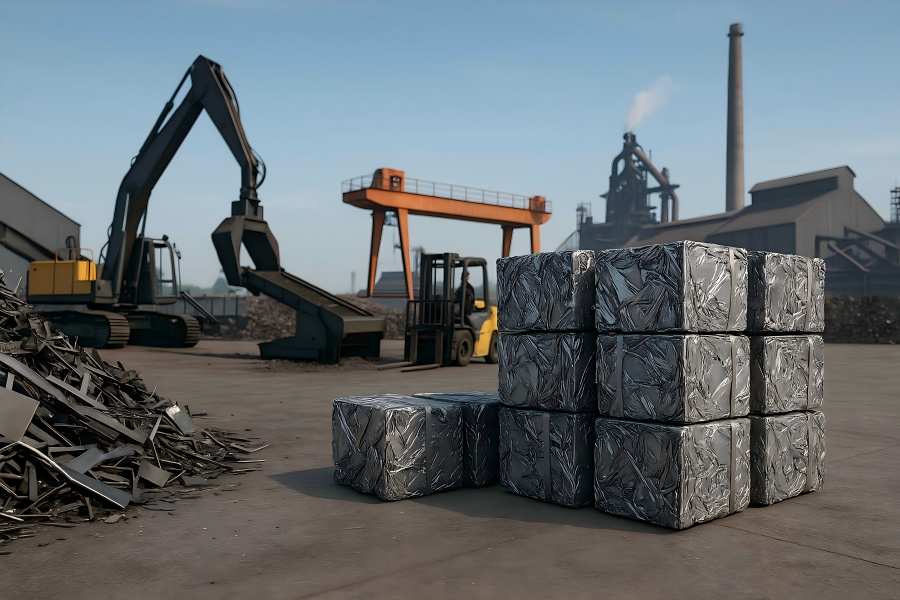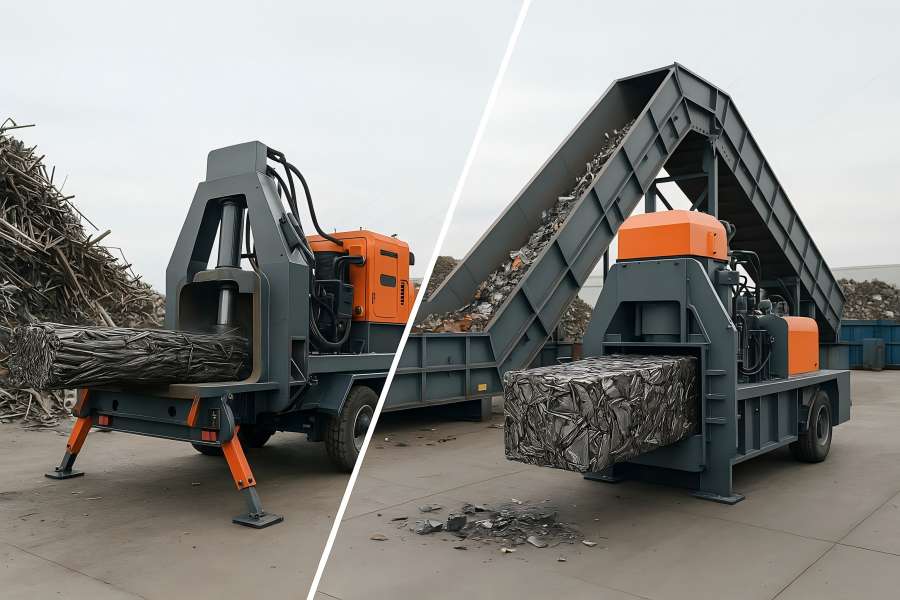Metal balers streamline metals handling by compacting loose, irregular scrap into dense, uniform packages. This raises payloads, steadies processing, cuts storage costs, and brings order to messy streams. With the right machine and workflow for the material, baling delivers double digit gains in logistics, melt yield, and labor productivity from stamping offcuts to steel mill home scrap.
This article explains where balers create value, the main machine types, the integration choices that drive results, and the KPIs that prove return on investment.
What a metal baler actually does
At its core, a metal baler is a hydraulic press that compacts scrap inside a chamber and ejects a tied, strapped, or interlocked “bale”. That simple action drives four big wins:
- Densification: Loose sheet, light gauge, turnings, wire, and mixed light iron occupy huge volume per tonne. Baling collapses voids and interlocks geometry, raising density several-fold.
- Uniformity: Consistent bale dimensions and density enable predictable furnace charging, shred feed, or shear staging.
- Logistics efficiency: More tonnage per truck or container, fewer pickups, fewer forklift moves, and tighter yard stacks.
- Quality & compliance: Bale formats shed loose pieces and contain fines; with proper prep, they lower contamination and help environmental controls (fewer wind-blown scrap fragments, better coolant recovery from turnings when you briquette).
Baler architectures and where they fit
Different materials and operating models call for different machines:
- Channel (single-ram) balers: Continuous feed and continuous bale formation through a channel. Great for high volumes of consistent, light-gauge scrap (stamping skeletons, sheet trim, UBCs in MRFs).
- Two-ram balers: A secondary ram forms and ejects discrete, high-density bales. Excellent for nonferrous, wire, and mixed streams that need separation and reliable bale tying.
- Shear baler/loggers (mobile or stationary): Combine shearing and baling. Ideal for ELV hulks, demolition scrap, and heavy sections cut to spec, then baled or logged for transport.
- Briquetters (chip swarf compaction): Specialized press forming dense pucks from steel/aluminum turnings, recovering cutting fluids and reducing oxidation in melt.
- High-density box balers / lid balers: Discrete batch compression in a box and ejection; often used for heavy gauge but compressible shapes where continuous feed isn’t practical.
Typical density targets (indicative ranges; your spec and buyer requirements govern):
- Light ferrous (sheet/light iron): ~0.7–1.3 t/m³
- Baled car body logs: ~0.5–0.9 t/m³ (log/bale formats vary by market)
- UBC (aluminum cans): ~0.4–0.7 t/m³
- Copper/Al wire & solids (two-ram): ~1.0–2.0 t/m³ (material-dependent)
- Steel swarf briquettes: ~1.5–2.5 t/m³
Application map
| Sector / Site | Dominant Scrap | Pain Point | Typical Baler | Output & Gains |
| Automotive stamping | Sheet skeletons, press trim | High volume & low density | Channel baler | Continuous bales; truckload payload ↑, yard moves ↓ |
| Powertrain & machining | Steel/Al turnings with coolant | Wet, fluffy, oxidizes | Briquetter | Dense pucks; coolant recovery; melt yield ↑ |
| Vehicle dismantling (ELV) | Car bodies, mixed assemblies | Bulky hulks, travel between yards | Mobile shear-baler/logger | Logs/bales on site; transport cost ↓ |
| Steel service centers | Plate/coil trim, bundles | Mixed sizes, floor space | Channel or box baler | Stackable bales; safer handling |
| Demolition & construction | Rebar, light iron, mixed | Irregular, site-to-site | Mobile shear-baler/logger | On-site densification; fewer haul-offs |
| Appliances (white goods) | Thin gauge steel, mixed | Volume, depollution first | Channel or lid baler | Bale stacks; MRF synergy |
| MRFs & can plants | UBC, foil | Bulky, low mass/volume | Two-ram or channel | Dense UBC bales; shipping efficiency |
| Wire & cable processors | Cu/Al wire, harnesses | Entanglement, contamination | Two-ram | High-value bales; purity maintained |
| Ports & shipyards | Plate offcuts, sections | Export logistics | Shear-baler/logger | Export-ready packages |
| Foundries | Gating returns, light stampings | Charge control | Box or channel | Predictable charges; melt consistency |
| Steel mills | Home scrap, crop ends, thin | Intra-plant logistics | Stationary shear/baler | Furnace feed uniformity |
Automotive parts manufacturing (stamping plants)
Scrap profile: Sheet skeletons, coil edge trim, punched slugs. Volumes are large and steady, with predictable alloy mixes.
Best fit: Channel balers on each scrap line or after a centralized conveyor system. Automatic tying and bale counters integrate with production reporting.
- Densities push payloads closer to legal weight limits; 1–2 trucks/day might become 0.5–1 truck/day for the same tonnage.
- Uniform bales eliminate “springy” sheet piles that collapse unpredictably in yard stacks.
- Alloy-segregated lines preserve value (e.g., keeping mild steel separate from AHSS or coated steel).
Powertrain & machining variant: Where chips dominate, briquetters are the right tool. They can recover cutting fluids for reuse and dramatically reduce oxidation and melt loss in furnaces.
Vehicle dismantling and ELV processing
Scrap profile: Whole car hulks (after depollution), mixed ferrous with plastics and residuals.
Best fit: Mobile shear-baler/loggers that can be positioned near the pull-down area or dispatched between yards.
Why it works:
- Hulks are compressed into transportable logs/bales, raising payloads and lowering haul-offs.
- Shear capability reduces length to export/mini-mill specs.
- Mobility aligns with variable inbound volumes and temporary work sites.
Steel service centers and metals distribution
Scrap profile: Plate drops, strip trim, bundle ends, short pieces—clean, known grades.
Best fit: Channel or box balers feeding standardized bale dimensions for neat, high stacks.
Why it works:
- Housekeeping and safety improve (fewer loose edges, fewer forklift “picks”).
- Segregation by grade preserves premium pricing.
- Integrates with coil slitting lines via chutes or conveyors.
Construction and demolition (C&D)
Scrap profile: Mix of light structural shapes, rebar offcuts, sheet, and incidental nonferrous.
Best fit: Mobile shear-baler/loggers deployed to job sites or used centrally with roll-off bins.
Why it works:
- On-site densification cuts truck runs and makes general contractors happy by clearing space quickly.
- Shearing long lengths eliminates awkward, low-payload loads.
Appliances (white goods) and consumer durables
Scrap profile: Thin-gauge coated steel and some nonferrous parts; depollution and plastics removal required upstream.
Best fit: Channel or lid balers after depollution and basic dismantling.
Why it works:
- Uniform bales integrate with MRF and shredder buyers.
- Product flow is steady from retail take-back or municipal collection programs.
MRFs and UBC (aluminum beverage cans)
Scrap profile: Low-density aluminum cans and sheet.
Best fit: Two-ram or channel balers designed for UBC bale specs and fast tying cycles.
Why it works:
- Bale density is everything: it drives freight, storage, and export container economics.
- UBC buyers demand consistent bale integrity and moisture controls.
Wire harnesses and high-value nonferrous
Scrap profile: Copper and aluminum wire, harness looms, profiles.
Best fit: Two-ram balers for discrete, high-integrity bales with robust tying.
Why it works:
- Two-ram control maintains bale dimension and density across variable feed profiles.
- Cleaner bales support higher realized prices and fewer downgrades.
Machine shops and foundries handling turnings
Scrap profile: Steel or aluminum swarf with cutting fluids; foundries often have small, frequent returns.
Best fit: Briquetters for turnings; box/channel balers for light stampings and gating returns.
Why it works:
- Briquetting squeezes out coolant (captured for reuse) and creates dense pucks that charge cleanly with lower oxidation.
- Foundries gain consistent charge rates and less spillage around furnaces.
Ports, shipyards, and heavy fabrication
Scrap profile: Plate offcuts, pipe, hull sections, and light mixed scrap.
Best fit: Shear-baler/loggers and high-density box balers for staging export shipments.
Why it works:
- Export rules and container loading reward dimensional consistency and stackability.
- On-dock densification compresses timelines between fabrication and outbound logistics.
Steel mills (home scrap and crop ends)
Scrap profile: Mill “home scrap”—edge trim, crop ends, rejected light gauge pieces—along with purchased light ferrous.
Best fit: Stationary shear/balers with high cycle reliability.
Why it works:
- Uniform, pre-measured packages help charge control in BOF/EAF operations.
- Baling thin, springy cuttings prevents “bridging” in hoppers and charge buckets, smoothing tap-to-tap times.
Integration details
- Feed and pre-sort: Use conveyors, air knives, and magnets/screens to remove fines and tramp (sand, glass, dirt) that can damage hydraulics or downgrade bales.
- Alloy and grade control: Dedicated lines or color-coded totes preserve value; tie bale IDs to ERP lots.
- Automatic tying and counters: Essential for audit trails and traceability; integrate bale ID, weight, grade, and timestamp.
- Hydraulic power and duty cycle: Size HP/kW and cooling for your true duty cycle; undervaluing heat rejection kills uptime.
- Mobility vs. installation: Mobile units trade ultimate density for the ability to go to the scrap; stationary systems win on throughput and automation.
- Safety and environmental: Guards, light curtains, interlocks, and LOTO procedures are non-negotiable. Coolant and fluid management around briquetters and ELV depollution must be designed in.
KPI framework and a worked ROI example
Core KPIs:
- Bale density (t/m³) and weight per bale
- Throughput (t/hr) and cycle time (sec)
- Availability (%) and mean time between interventions
- Contamination (%) and moisture (%) for certain nonferrous streams
- Logistics metrics: trucks per tonne moved, container fill factor, yard turns
- Recovery metrics: coolant recovery (L/ton), melt yield (%), downgrade rate (%)
Example: automotive stamping ROI (illustrative):
Scrap generation: 30 t/day of light-gauge steel, 260 working days → 7,800 t/year.
Loose density ~0.25 t/m³. Tractor-trailer volume ~40 m³.
- Loose payload per truck ≈ 10 t (volume-limited).
- Trucks needed: 780 trips/year.
After channel baling, effective density ~1.0 t/m³ with stackable bales.
- Truck becomes weight-limited at ~22–24 t.
- Trips drop to ~330–355/year.
Freight savings: ~425 fewer trips. At $250/trip, ≈ $106k/year.
Price uplift: Cleaner, uniform bales earn, say, +$10/t → $78k/year.
Labor/handling savings: fewer forklift moves, tighter stacks → estimate $20–30k/year.
Total annual benefit: ≈ $204–214k.
If installed cost for a fully integrated channel baler line is $600–750k, simple payback ≈ 3.0–3.7 years, with upside from avoided injury/OSHA findings and better furnace performance downstream.
Numbers vary by market and plant, but the structure—payload, price, handling, and quality—holds across sectors.
Sector-specific tips
Stamping plants: Keep alloy lanes separate and labeled; bale tying integrity is critical for robotized handling.
ELV yards: Always depollute before baling; plan concrete pads and stormwater containment around the machine.
Service centers: Aim for uniform bale dimensions that match standard pallet patterns to optimize racking.
Machine shops: Put a chip wringer upstream of the briquetter if coolant recovery is a priority; segregate ferrous and aluminum chips to avoid cross-contamination.
MRFs: Moisture is a hidden cost—design can bunkers with drainage and cover to keep UBC weight honest.
Ports/shipyards: Check destination packing specs; a slightly different bale dimension can push container fill from 88% to 96%.
Mills/foundries: Focus on charge behavior—avoid bale formats that “bridge” in chutes; pilot and document charge rates before scaling.
Energy, noise, and siting considerations
- Power draw: Nameplate kW is only part of the picture; duty cycle, pump control, and heat rejection define real energy use. Variable-displacement pumps or smart hydraulics can cut idle consumption.
- Noise & vibration: Install acoustic panels if near offices; isolate pads reduce transmitted vibration to adjacent processes.
- Hydraulic fluid: Choose fluids and filtration with your climate and cycle in mind; cleanliness class targets pay back in seal and valve life.
- Footprint & traffic: Plan bale ejection lanes and forklift radii; avoid cross-traffic between raw scrap and finished bales.
Data and digitalization
Modern balers can log bale counts, densities (via weight and dimension capture), cycle times, and downtime causes. Tie the baler PLC to your MES/ERP so bale IDs carry alloy, supplier, shift, and quality flags. That traceability:
- Supports premium pricing on clean, single-grade bales.
- Simplifies supplier scorecards and charge-mix optimization.
- Shortens root-cause investigations when a furnace or shredder run misbehaves.




